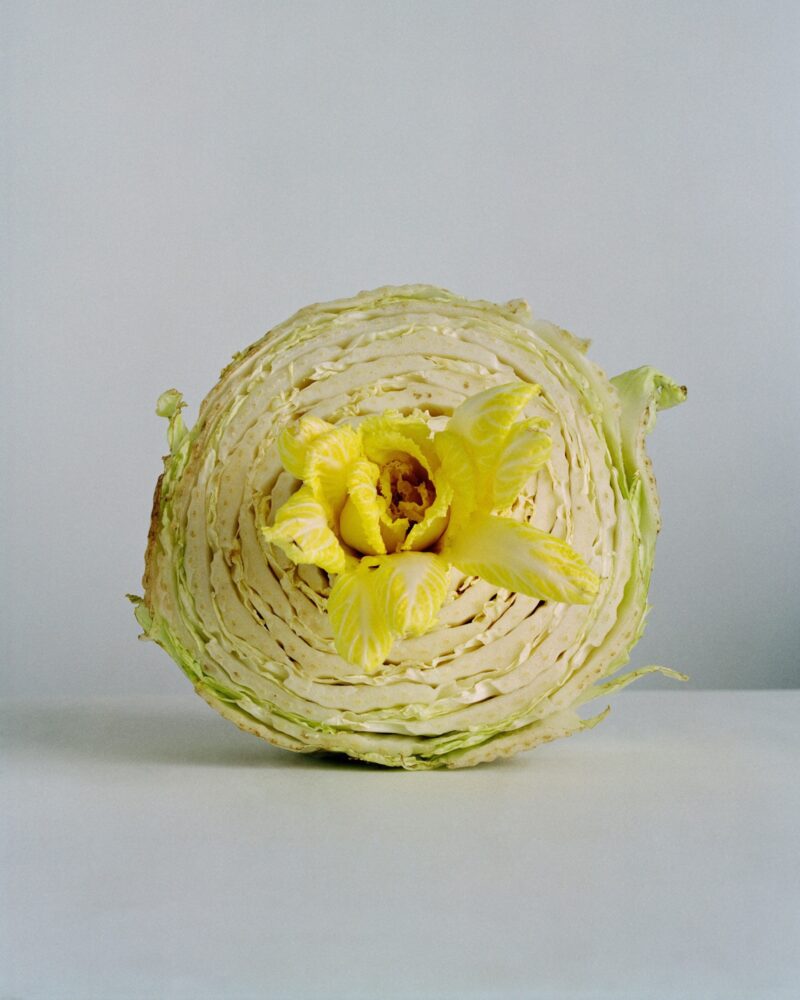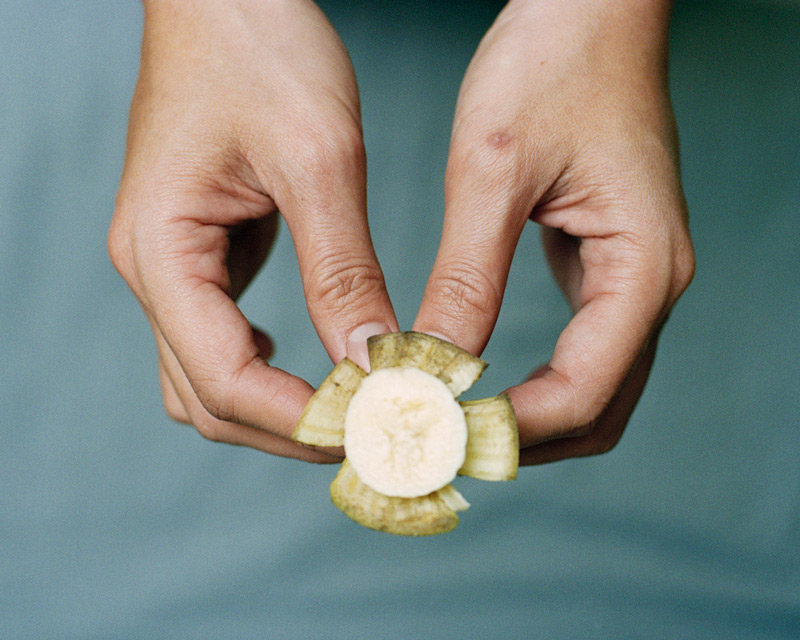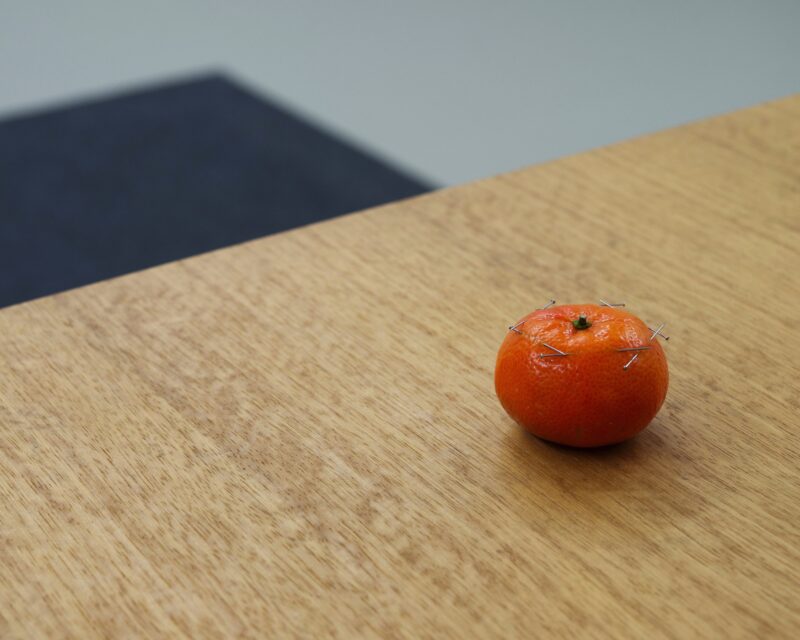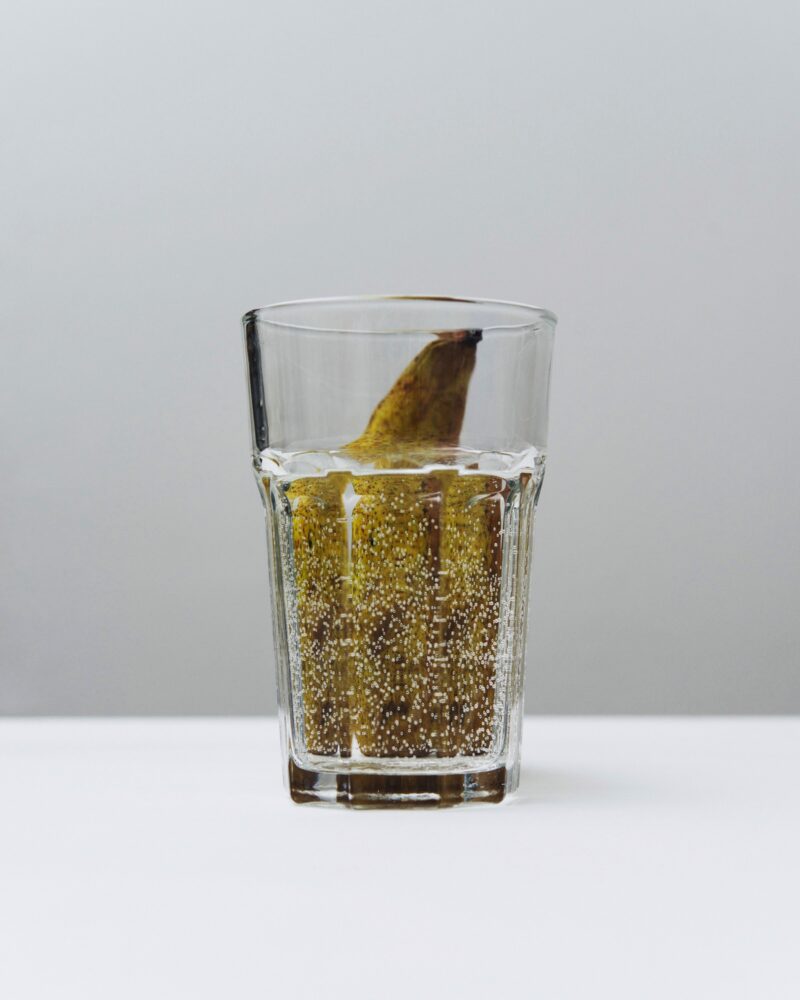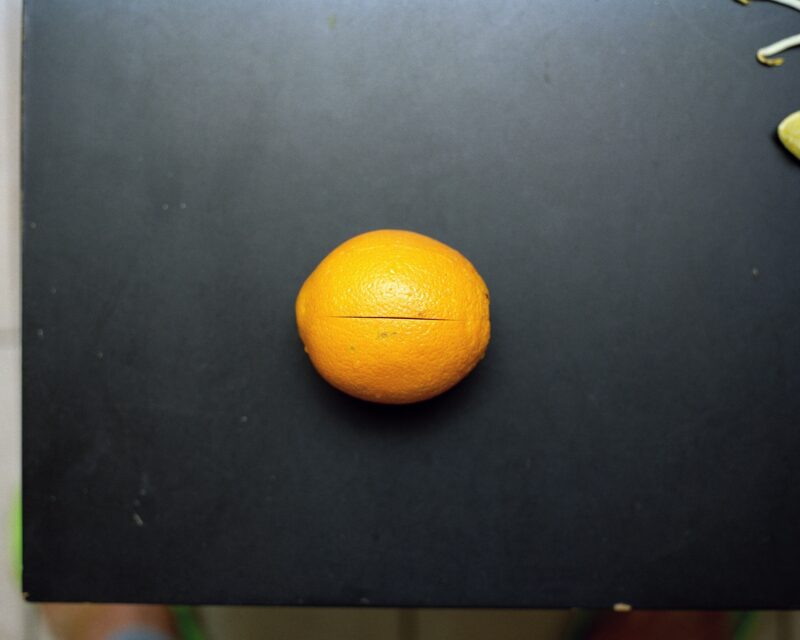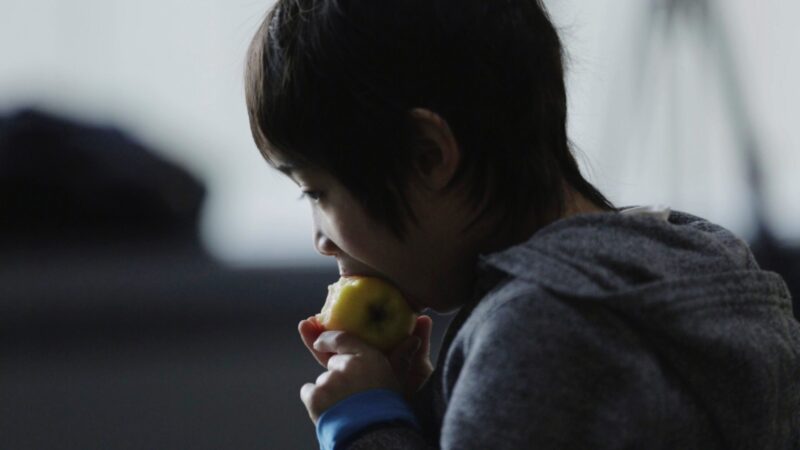[Summer 2021]
A Gift of Images
Par Sylvain Campeau
Characteristic of Chih-Chien Wang’s art practice is his intertwined use of photography and videography, so it might seem incongruous to approach his work from the angle of the still life. Nevertheless, allusions to this genre constantly arise in his work, although analysts and critics have never thought to make more of them than just that: allusions.
Assemblages of the everyday. When we look at the images, we are quickly convinced that this reference is not gratuitous. Foodstuffs, fruits, and vegetables take centre stage. Sometimes the composition is quite pared down: the elements are isolated in the centre of the image. One thinks of the series Cabbage Flower (2011), Pineapple (2011), and Apple After Shaore (2014), and the images Sad and Happy from the Orange series (2014), and there’s more. Or one can think of the groupings complemented by domestic objects: Grape and Tea Bag (2005), Banana in a Glass (2005), Watermelon, Coffee and Detergent (2009), and White Cans and Pineapple (2009). Or of more complex scenes: Oranges, a Glass Ball and Shadows (2016), Pomegranates, Plastic Packaging and Wood (2016), Stems and Orange Peels on Cardboard (2020).
The still life. In the view of Charles Sterling, a specialist in the genre, “An authentic still life is born the day a painter makes the fundamental decision to choose as a subject and to organize a group of objects into a plastic entity.”1 These objects often correspond to the category of domestic foodstuffs.
It took a number of variants to arrive at this all-encompassing, minimal definition: Giorgio Vasari’s cose naturali (“natural things”) in the late seventeenth century; stilleven, in Flanders around the same time, to designate “pieces of fruit, flowers, fish” or “parts of meals served”; bodegón, from the word bodega (“place where food is stored”), utilized to describe the cellar anterooms of small taverns in Spain.
These representations have a special connection with food consumed, and they highlight or celebrate the holding of banquets. The Greek term xeniae, for instance, designated delicacies, sweets, or pastries that friends sent to each other, especially during the Saturnalia.
Anne Cauquelin addresses the subject in her book L’invention du paysage. First, she explains that these “table gifts” are “presents ‘in kind,’ fruit baskets, rare dishes, pieces of wedding cake that will be eaten in memory of the dinner,” to preserve the moment thus commemorated, “which will be repeated sometime afterward.” These gifts were often accompanied by a painting portraying what had been sent, offering a “doubling of the thing in its visual representation.” Xeniae are reminders and remembrances of an occasion when people got together and shared good food, and also an invitation to repeat the experience, in solitary, with happy memories of a past event.
Wang’s intention is not to show meals or well-laid tables. In his works, even when the item from the plant world is not the sole subject, it is central, accompanied by few other objects and forming the climax (or one of them) of the representation.
In Wang’s works, foods cannot be considered ready for consumption. Among the many images that he has produced are those of strangely twisted pineapples (Pineapple series), bizarrely lacerated cabbages (Cabbage Flower series), a drowning pear (Pear and Glass Water, 2017), mutilated bananas (Banana Flower #1, Banana in a Glass, 2005), and the shrivelled remains of an eggplant stem (Stalk of Eggplant on Bookshelf, 2009). They are less destined for consumption than likely to evoke the time preceding consumption – preparation – or subsequent – being put in the trash (Apple After Shaore series). They are upstream and downstream of any consumption, even more than objects in a traditional still life are. Once transfigured and posed among familiar everyday objects, food acquires a different stature. It lends itself to a play on sense, before even being subjected to the play of the senses.
The video works. Wang’s video works occasionally evoke consumption. Time Measurement #3 #4 #5 (2008) presents a three-channel tableau. At one end of the triptych, hulled tips of green beans fall one by one. At the other end, pieces of strawberry emerge behind a translucent surface. This material gives rise to the gesture of writing a story in Chinese, which we decipher through subtitles, gradually coming to the realization that it’s a dream. It involves strips of dried squid, infested with worms and yet edible. We note that foods are still the subject.
The theme of food is thus quite present in Wang’s work. Even in his videos, set tables or prepared dishes are not the main subject; rather, there are isolated elements, not yet processed or ready to be eaten. In fact, to the contrary, the foods, without exception, are still in their raw state, pending preparation, or else they have been strangely started. They are not finished, completed foods; they are still-disparate items in the course of being processed, or remains abandoned after incomplete consumption. Or else they have been altered, randomly or deliberately, and their form or arrangement eccentrically evokes something else.
The still life is a fundamental part of a gift, and this is even more obvious in Wang’s work. For the foods often seem caught up in the cycle of preparation. Even more than consumption, there is the question of establishing the conditions for sharing. Or else the remains of a meal, when there is a shot of forgotten victuals, leaving us with the memory of a mouthful. These are images that celebrate either the future act of eating or the fact of having done so. The food, prepared or left as is, will be, or has been, an opportunity to share.
The conjurings of food preparation stress the reality of performing this action together; they propose that the meal is marked by effort and work, by the pooling of resources, by the gathering of guests. Eating is a collective affair: preparing to share foods is an act of solidarity. As they do in the dream recounted in Time Measurements #5 – Strawberry, interpersonal connections and food go together.
Wang’s exhibitions are not made up simply of photographs and videos. Activities are suggested. Indeed, sometimes Wang wants spectators to participate more fully in the encounter. In When the Shadows Change Colour (2014), there was an invitation to pick up small images or dried leaves – to take and leave behind items. For The Act of Forgetting (2015), spectators were to perform actions described by Wang.
Things are offered. Instructions invite exchanges. The exhibition context provides Wang with an opportunity to encourage people to act, to manifest themselves, to take and to give. To his offer corresponds an active counterpart: to share, exchange.
The confessions: offerings. For Wang, the still life is not an isolated reference, as other of his themes and interventions in the exhibition space also contribute to creating a spirit of giving and exchanging.
The video I Want to Be Reminded (2014), at the heart of the exhibition When the Shadows Change Colour, involves a conversation between two women. We quickly understand that this is a fabrication and not the capture of a real moment of intimacy. In their exchange, the women allude to a letter that one has sent to the other and talk about what it might have meant then, and might still mean today. Their dialogue reveals that there is a strong bond between them: they are a couple who emigrated from Taiwan. To one’s desire to bring up the past is opposed the other’s desire to live in the present. The work summons and examines what each of them has become after moving to a new country.
But there is a turning point in the video. It occurs when Wang, out of frame, intervenes to ask one of the women to pose a specific question to Yushan, his life partner. She is a known figure to those familiar with his work. We then understand that the video is a fiction, created on the basis of a letter, itself perhaps also imagined, about a relationship that is very real.
Coming after this exhibition was The Act of Forgetting, in which the signs of artifice are clearer. In the video projected on a gigantic screen, people arrive, one by one, in the middle of a big room. Technicians are there too, to toil on the rail that surrounds the centre of the room, on which a trolley slides. Those who take their places there are questioned by Wang, whom we glimpse occasionally and hear indistinctly. In this work, the question of creation is constantly posed. People introduce themselves and talk about the scene that they will play – or not – facing everyone, recorded by a camera that films as it circles around them. They also mention personal experiences, although we don’t know if these belong to their characters or them. Some play music; others discuss art, dance, acting. It ends with a musical performance by a santur player, who is joined by a group.
All of the stories told have something unique and singular in common: they are those that end up defining and shaping a person. But these confessions before the camera could well be ploys. We can’t be sure that they truly belong to the person who is telling them. Perhaps they’re part of the game. But it doesn’t matter. They are, they exist, offered to everyone as part of a rehearsal, which is as much a work in itself as a preparation for another work. Thereafter, they are accessible to those who can seize them, retell them, without their losing their strength or impact.
Like the still lifes, these stories are fabricated. They form a fictional grouping, and we don’t know whether or not to think they’re true. They, too, have been released, given, offered, and taken back – at least by Wang, who embroiders on them and confers weight and dignity upon them. They are capable of lending humanity to our lives and making the one who savours them a confessor, an alter ego, an attentive and sympathetic ear. The story heard, recounted, could be mine or yours, and could resemble some circumstance that we have experienced.
The effect of the gift. It seems to me that this entire undertaking of giving and sharing leans into a sort of existential and liberating effort. Jacques T. Godbout, researcher at the Institut national de la recherche scientifique, sees in each gift a sort of leap beyond determinism. It makes it possible to evade the vaguely self-interested giver–giver dictates in commercial exchanges. It frees the other from the obligation of a quid pro quo, of a sort of return on an advance. The still life is therefore perfectly appropriate as a genre, in its constitutive principles, to be integrated into Wang’s body of work. And to form a fundamental image of what is at play. In his videos, through the exchange and the giving of human beings’ formative stories, there is a question of evading what in them determines us and defines us too closely. Recounting these stories and entrusting them to others means no longer suffering under their yoke. The experience of creating, in this effort to reach out to the other and ask for exchange, is another way of escaping, together, from what determines and defines us.
For Wang, it makes it possible to fulfil his desire of creating “a work that listens.” Translated by Käthe Roth
1 Charles Sterling, Still Life from Antiquity to the Twentieth Century, trans. James Emmons (New York: Universe Books, 1959), Paris, Macula, 1985.
2 Anne Cauquelin, L’invention du paysage, Paris, Éditions Plon, 1989, 181 p.
3 Ibid., 97 (our translation).
4 « A work that listens », Correspondence with the author, le 24 février 2021.
Sylvain Campeau contributes to many Canadian and European magazines. He is also the author of the essays Chambres obscures : photographie et installation, Chantiers de l’image, and Imago Lexis, as well as seven collections of poetry. He has also edited books on visual arts and literature. As a curator, he has organized forty exhibitions.
[ See the magazine for the complete article and more images : Ciel variable 117 – SHIFTED ]



